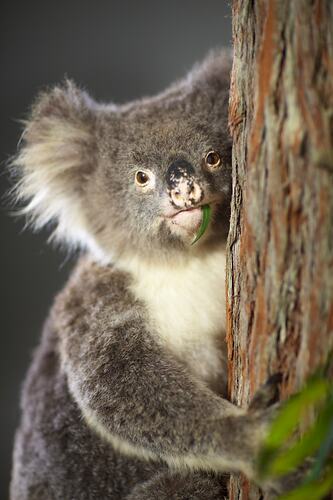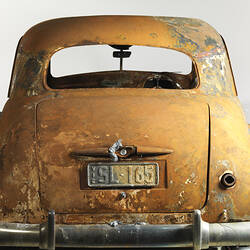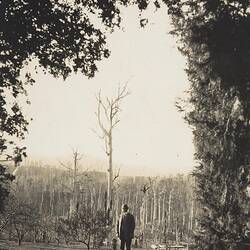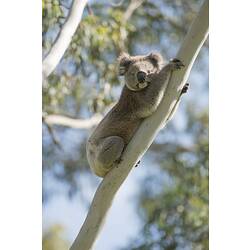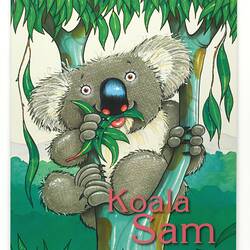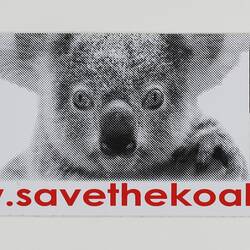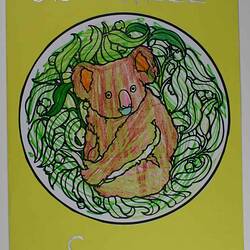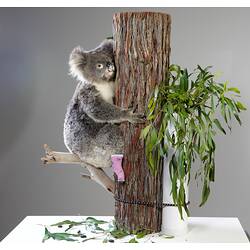Summary
The life, death and acquisition of the Sam the Koala specimen into MV collections.
Discovered
Sam the koala was discovered in burnt bushland on Samson Road on 1st February 2009, during a defensive back-burning operation in Mirboo North, 150 kilometres south-east of Melbourne.
Mark Pardew, a firefighter for the Department of Sustainability and Environment (DSE), photographed Sam receiving water from the drink bottle of Country Fire Authority (CFA) firefighter, David Tree.
This back-burning operation was part of the containment response to three bushfires located north-east of Mirboo North, which had started on 28th and 29th January. These fires subsequently became known as the Delburn Complex fires, which destroyed 30 homes and burnt 6,350 hectares, with approximately 60 per cent of the burnt area in forest plantations.1
The Delburn Complex fires were contained on 3rd February but still required constant patrolling, mopping up and blacking out.2
Rescue
Teams of trained wildlife rescue volunteers had been on alert since the Boolarra fires started on 28th and 29th January. Members of Wildlife Rescue and Protection Inc. (WRAP), a specially trained volunteer group who assist in wildlife rescue, were first alerted to Sam on Wednesday 4th February, but were not provided with the location details until 6th February. WRAP immediately activated local members to rescue her on Friday 6th February, a day before Black Saturday.
This complex and challenging rescue operation was led by Cathy and Mike Beamish and overseen by Donna Zabinskas. Sam was found approximately 15 metres up a tree and was reluctant to come down. In the absence of an accredited tree climber, rescuers Cathy and Mike taped two extension poles together, extended them to 15 metres, and gently encouraged her down the tree. It was a hot and difficult task requiring considerable patience. It took over an hour to coax Sam down.
As with most rescued wildlife, Sam assumed the name given to her by her rescuers, which was based on the place where she was rescued: Samson Road.
Following her rescue, Sam was transferred to the Animal Clinic Morwell for triage by vet Dr John Butler. She was then placed in the care of the Southern Ash Wildlife Shelter, Rawson, north of Moe, on Sunday 8th February.
Recovery from burns
Colleen Wood, Manager of Southern Ash Wildlife Shelter was able to establish, via tooth wear, that Sam was approximately 2 to 4 years old. She had second-degree burns to her front feet. Her rear feet suffered the most with third-degree burns. Also known as 'full thickness burns', these burns destroy the full thickness of the skin and the tissues below.3
Sam also presented with blistering on her outer eyes, a typical symptom of a burns victim.
Sam's treatment included pain relief, daily antibiotic for her burns and eyes, eye drops, daily dressings for her feet, and supplementary feeding. The koalas treated by the shelter received supplementary feeding to make up for the loss of 10% of their body mass caused by shock and dehydration.
Sam's bandages were removed in mid-March, and by early April after her paws had toughened she was able to be placed in an outdoor enclosure. While she had fully recovered from her burns, she continued to receive supplementary feeding and treatment for her eyes.
Sam - 'Placid and sweet natured koala'
Each koala has its own unique personality. Sam was described as quiet, 'beautiful', and 'well-behaved', and easily managed compared to some of the other koalas who had forceful personalities. Sam had a strong maternal instinct, and enjoyed nursing juvenile koalas, many of whom would have been from the same local colony.
When Sam's bandages had been reduced to two paws she would climb on top of her indoor pen and survey all the others below her. One memorable occasion Sam escaped from her pen in the early hours of the morning and proceeded to climb up on top of a desk. She sat on the two-week old fax machine and consequently broke it.
Sam was much loved by her carers at the wildlife shelter. One of Sam's carers, Vicki Hams, described her as a:
'particularly placid, sweet natured koala. She loved her formula and gobbled it with gusto each morning and evening and would crawl across the branch and reach for it hungrily! She did not try to bite when having her bandages changed or her injections or her eye drops. She patiently allowed the joeys to crawl on her back or her head and would have made a good mother herself! I have a wonderful photo of a joey plonked on the head of the sleeping Sam. Sam snored when she slept! She adored a selection of various gum leaves and again, greedily ate the best gum immediately it was replenished in her enclosure.'4
Sam - international media star
Koalas are recognised around the world as a unique and much-loved Australian icon immortalised in soft toys, 'Blinky Bill' stories, and tourist postcards.
The publication of Sam's image, just days after the shocking news of Black Saturday, touched millions of people. Sam became a symbol of hope and resilience amidst the loss and trauma of Australia's worst bushfires on record. Sam's image also gave prominence to the impact of the bushfires on native animals, and the important role of wildlife rescue.
Mark Pardew's image of Sam featured on the front page of the Herald-Sun on Tuesday 10th February 2009.
Her image was subsequently picked up by media outlets around the world. SAWS were overwhelmed by requests for interviews and opportunities to film Sam. In addition to local and national media outlets, interest came from Asia, Italy, USA, Japan, UK, Germany, China and Sweden. Sam's story was featured on numerous national and international shows, including the NBC, Ellen De Generes, and television programs in the UK, France, Germany and China.
The media and public attention was very intense. Two volunteers were required to field phone calls for 12 hours each day for a period of four weeks. International calls came at all times throughout the night.
Not only did this constant media attention intrude on Colleen Wood's private home life, it seriously impacted SAWS ability to respond to the ongoing phone calls reporting injured wildlife and to coordinate search and rescue. By 17th February Colleen Wood sought the pro bono services of TressCox Lawyers to manage all media enquiries relating to Sam.
Like any media star of today, Sam quickly established a strong web presence and soon became the most famous koala in the world. A host of websites, blogs and a wiki were created to track her progress. Her rescue video is a YouTube sensation, and she even has a Facebook page with over 60,000 fans.
Sam's media success generated a huge public response in the form of letters, emails and offers of assistance. While much of this was welcome, the volunteers were soon avalanched by over 30,000 emails. SAWS created a 'Sam the Koala' website to help manage the overwhelming public interest and to provide accurate information about Sam and her recovery.
Death from Chlamydia
The main threats to koala populations are the loss and fragmentation of habitat (from bushfires and urban development), domestic and wild dogs, road traffic, cow attacks and chlamydiosis.
Chlamydia is an organism that is widespread in koala populations and causes chronic diseases in the urogenital tract (C. pecorum) and the respiratory tract (C. pecorum and C. pneumoniae). It can cause infertility, blindness and if not treated and monitored will ultimately cause a painful death. It is believed that stress due to habitat loss and other threats, such as dogs and cars, increases the incidence of symptoms.5
When Sam was first rescued she was tested for chlamydiosis, but the result was negative. On 7th May Sam developed urinal problems and together with the lack of improvement with her eyes, chlamydiosis was suspected. The results of these second tests confirmed that Sam was suffering from a urogenital form of chlamydiosis. Sam's medication was doubled and she continued to be treated for this condition.
Sam's weight was stable at 7.8kgs until 29th July, and then it dropped to 6.8kgs. On 31st July Sam underwent an extensive ultrasound. This abdominal investigation indicated that she needed surgery.
Sam had exploratory surgery on 6th August 2009 for ovarian cysts. It was discovered that the disease was well advanced and beyond treatment. Six months of caring for Sam sadly came to an end, and Sam was euthanized during surgery.
New home at Melbourne Museum
Victorian native animals are protected by the State of Victoria's Wildlife Act (1975) which is administered through the Department of Sustainability & Environment (DSE). After Sam's death, DSE transferred her into the custody and care of Museum Victoria. Museum Victoria is authorised under the Museums Act (1983) to act as an official repository for specimens of native animals which may have special scientific, cultural or historical significance.6
Sam's placement in Melbourne Museum will preserve her story, and her extraordinary role in providing a source of hope to those devastated by the February bushfires. She will also play an important role in educating the community about issues relating to koalas, changes in habitat, the impact of fire on wildlife and the role of wildlife rescue.
Sam's initial display was in the foyer at Melbourne Museum until 5 May 2010. The display included video footage from the original video of Sam when she was first discovered in the burnt bushland in Mirboo North, and a segment of Sam in the Southern Ash Wildlife Shelter nursing a young koala on her back.
On 2 July 2010, Sam moved to her permanent home in the Wild: Amazing animals in a changing world exhibition at Melbourne Museum.
References:
2. 'State Fire Emergency Coordination Plan 1900hrs Wednesday 4 February 2009 to 1900 hrs Saturday 7 February 2009'; source: http://www.royalcommission.vic.gov.au/Documents/Document-files/Exhibits/WIT-002-001-0813
3. Dr Anne Fowler & Colleen Wood, 'Treating Burnt Wildlife'; source: http://www.ozarkwild.org
4. Vicki Hams, wildlife volunteer, Southern Ash Wildlife Shelter.
5. Davies NA, Gramotnev G, McAlpine C, Seabrook L, Baxter G, Lunney D, et al. (2013) Physiological Stress in Koala Populations near the Arid Edge of Their Distribution. PLoS ONE 8(11): e79136. https://doi.org/10.1371/journal.pone.0079136
6. Museums Act 1983, Authorised Version No. 042, 1 March 2015.
http://www.legislation.vic.gov.au/Domino/Web_Notes/LDMS/LTObject_Store/LTObjSt9.nsf/DDE300B846EED9C7CA257616000A3571/AC3474F5917725D1CA257DF80000248E/$FILE/83-9903aa042%20authorised.pdf
More Information
-
Keywords
Black Saturday Bushfires, 2009, bushfires, Environmental Activism, koalas, Wildlife
-
Localities
-
Authors
-
Article types
